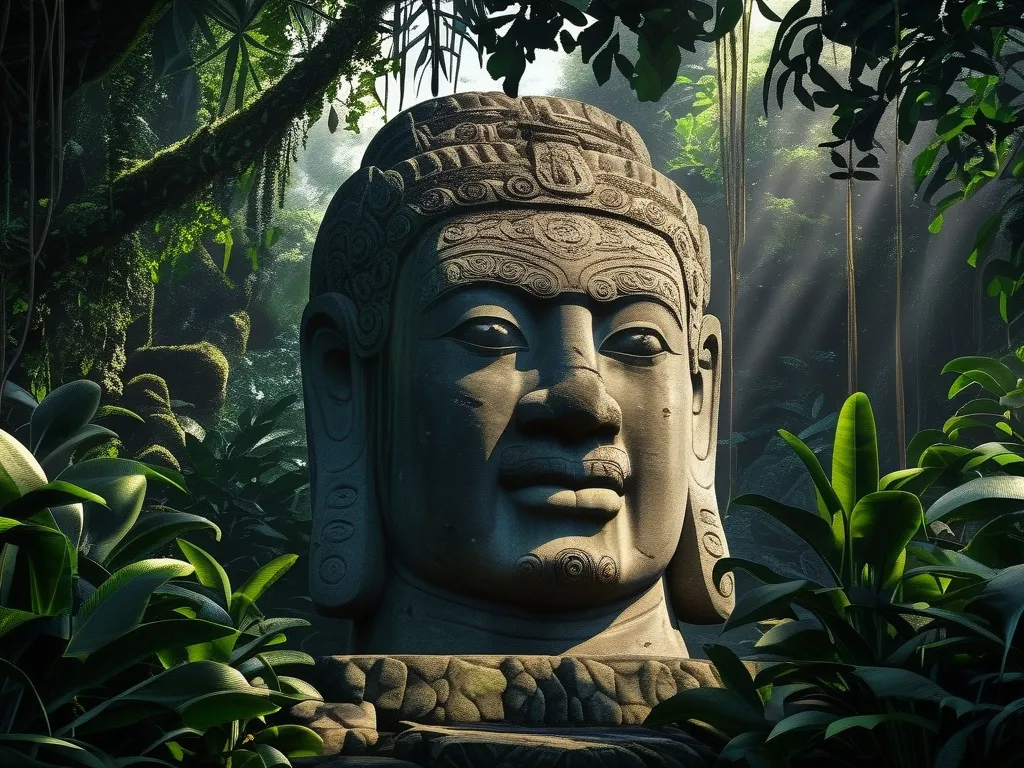The Olmec colossal heads stand as silent sentinels of an ancient civilization, captivating the imagination of all who encounter them. These massive stone sculptures, scattered throughout the lush jungles of Mexico’s Gulf Coast, are a testament to the ingenuity and artistic prowess of the Olmec people.
Picture yourself stumbling upon one of these colossal heads in the dense tropical forests of Veracruz or Tabasco. You’d be awestruck by their sheer size – some reaching heights of 11 feet and weighing up to 25 tons. It’s mind-boggling to think that these masterpieces were carved from single basalt boulders, often transported from quarries miles away. How on earth did they manage that feat with ancient technology?
What’s truly fascinating about these heads is their individuality. Each one is a unique work of art, sporting distinct facial features and adornments. Some wear elaborate headdresses, while others are crowned with intricate designs featuring jaguar paw prints. This diversity has led many archaeologists to speculate that each head might represent a specific Olmec ruler or important figure.
The craftsmanship involved in creating these heads is nothing short of remarkable. Imagine the patience and skill required to carve out every detail using stone tools – from the pupils in the eyes to the dimples in the cheeks. And here’s a little-known fact that adds another layer of wonder: these heads were originally painted in vibrant colors. Over time, the paint has faded, leaving us to wonder how breathtaking they must have looked in their prime.
Now, let’s dive into the mysterious origins of these colossal heads. There’s been no shortage of theories over the years, some more outlandish than others. One controversial idea suggested that the Olmecs were actually Africans who had sailed across the ocean. It’s an intriguing thought, but unfortunately, it doesn’t hold up to scientific scrutiny.
The truth is, the physical characteristics of the heads – like flat noses and full lips – aren’t exclusive to Africans. You can find similar features among indigenous Mesoamerican populations. Plus, there’s no archaeological evidence of African artifacts in the region, and genetic research points to the Beringian migration as the origin of Native American populations. So, while it’s an interesting theory, it’s best left in the realm of fiction.
So, who were the Olmecs, really? They’re considered one of the earliest and most influential civilizations in Mesoamerica. These folks were true pioneers, developing things like a writing system that predates even the Zapotec script. Their influence spread far and wide, with Olmec artifacts found as far away as El Salvador and Costa Rica.
But the big question remains: what was the purpose of these colossal heads? Were they portraits of rulers, as some speculate, or did they serve a more ritualistic or symbolic purpose? Some researchers believe these heads were moved during important rituals, possibly to assert dominance or political authority. In the Olmec city of La Venta, for example, four heads were strategically placed on the north and south sides, facing outward as if standing guard over the city.
Here’s an interesting tidbit: around 900 BC, some of these heads were buried. This could have marked the transition to a new era or honored the ancestors. But it also raises questions about the decline of the Olmec civilization. Unlike many other ancient cultures, the Olmecs didn’t leave behind a clear record of their downfall. Instead, their cities were gradually abandoned, paving the way for successor cultures like the Maya and Zapotec to rise to prominence.
The craftsmanship and scale of the Olmec colossal heads are undeniable testaments to the advanced skills of the Olmec artisans. However, let’s not get carried away with conspiracy theories about unknown advanced civilizations creating these masterpieces. The evidence points squarely to the Olmecs themselves as the creators of these amazing sculptures.
As we delve deeper into the world of the Olmecs, we begin to appreciate the complexity and richness of their culture. These colossal heads are more than just artifacts; they’re windows into a past that’s both familiar and alien. They remind us of the ingenuity and creativity of our ancestors and the mysteries that still await us in the depths of history.
In a way, these colossal heads reflect our own curiosity and desire to understand the past. They stand as silent guardians of a civilization that has left us with more questions than answers. But isn’t that the true allure of history? There’s always more to discover, more to learn, and more to marvel at.
When you think about it, history isn’t just about dates and events. It’s about the people who lived, created, and left behind their mark on the world. The Olmec colossal heads are more than just stone; they’re a testament to human creativity, perseverance, and the enduring legacy of a civilization that continues to captivate us to this day.
Let’s take a moment to appreciate the sheer effort that went into creating these monumental sculptures. Imagine the countless hours of labor, the meticulous planning, and the collective effort of an entire community to bring these heads into existence. It’s a reminder of what humans can achieve when we work together towards a common goal.
The Olmec civilization flourished from around 1200 BC to 400 BC, predating the more well-known Maya and Aztec cultures. They’re often referred to as the “mother culture” of Mesoamerica, influencing many aspects of later civilizations in the region. The colossal heads are just one aspect of their rich cultural legacy.
One of the most intriguing aspects of the Olmec culture is their apparent obsession with the jaguar. Many of the colossal heads feature headdresses with jaguar motifs, and jaguars are prominently featured in other Olmec artworks. Some researchers believe the jaguar held a special spiritual significance for the Olmecs, possibly representing a powerful deity or serving as a symbol of political and religious power.
The Olmecs were also pioneers in astronomy and mathematics. They developed a complex calendar system and were among the first in the Americas to use the concept of zero. This advanced knowledge is reflected in the precise placement of their monuments and the layout of their cities.
Speaking of cities, the Olmec heartland was home to several impressive urban centers. San Lorenzo, La Venta, and Tres Zapotes were among the most significant. These cities featured complex layouts with plazas, pyramids, and intricate drainage systems – a testament to the Olmecs’ advanced engineering skills.
But let’s circle back to those enigmatic colossal heads. One of the most perplexing questions is how the Olmecs managed to transport these massive boulders from distant quarries. Some theories suggest they used a combination of log rollers, sleds, and rafts to move the stones over land and water. It’s a reminder of the incredible feats humans can accomplish with determination and ingenuity.
The Olmec civilization’s sudden decline remains one of the great mysteries of Mesoamerican archaeology. Climate change, environmental degradation, and social upheaval have all been suggested as possible causes. Whatever the reason, the Olmecs left behind a legacy that continues to intrigue and inspire us millennia later.
In recent years, new technologies have allowed archaeologists to uncover even more secrets about the Olmec civilization. LiDAR (Light Detection and Ranging) technology has revealed previously unknown Olmec sites hidden beneath the dense jungle canopy. Who knows what other discoveries await us as we continue to explore this fascinating ancient culture?
As we ponder the mysteries of the Olmec colossal heads, it’s worth considering what they might mean for our own time. In an age of rapid technological advancement and global connectivity, what will we leave behind for future generations to marvel at? Will our achievements stand the test of time like these ancient stone sculptures?
The Olmec colossal heads serve as a powerful reminder of our shared human heritage. They speak to our innate desire to create, to leave our mark on the world, and to understand our place in the grand tapestry of history. As we continue to unravel the mysteries of the Olmec civilization, we’re not just learning about an ancient culture – we’re learning about ourselves.
So the next time you come across an image of one of these imposing stone faces, take a moment to appreciate the skill, effort, and cultural significance behind it. Let it spark your curiosity about the past and inspire you to leave your own positive mark on the world. After all, we’re all part of the ongoing story of human civilization, each of us adding our own unique chapter to the tale.
In the end, the Olmec colossal heads stand as a testament to the enduring power of art and human ingenuity. They remind us that even in the face of time’s relentless march, some creations can capture our imagination for millennia. And who knows? Maybe thousands of years from now, future civilizations will look back on our time with the same sense of wonder and curiosity that we feel when gazing upon these ancient stone faces.






